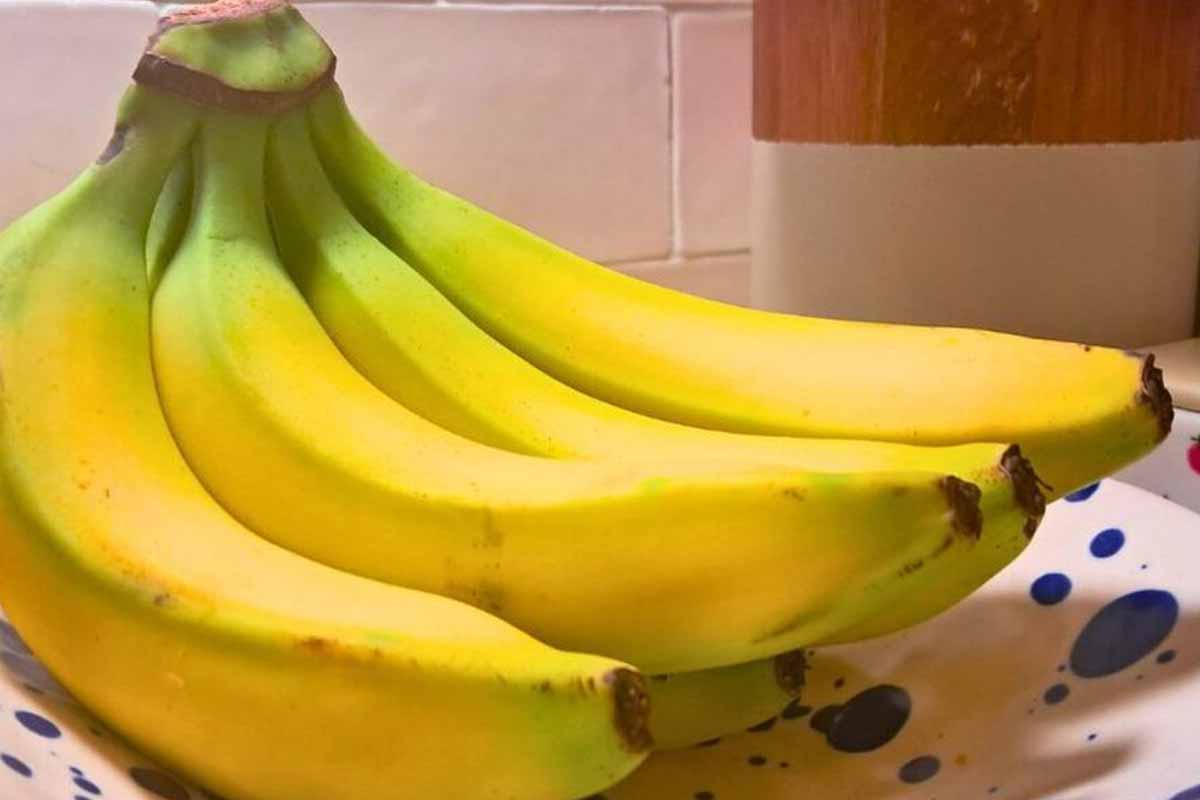A cool, airy countertop zone works better than a dark cupboard or a cold shelf. The secret sits at the top of the bunch: the stems release a gas that speeds up ripening. Seal that point and slow the clock. With simple habits, bananas keep their sunny color longer, taste better, and stay firm without gadgets, lab tricks, or waste.
Keep ripening in check with a sealed stem
Wrap the entire stem cluster tightly. Use plastic wrap and press it well so no air sneaks in. The stems release ethylene, a natural gas that tells fruit to ripen faster. When you block the gas from spreading, you ease the chain of changes that cause browning and soft spots in bananas.
Press the wrap snugly around the crown. Do not cover the whole bunch; target only the top. This small barrier reduces contact between the gas and oxygen. Because the signal weakens, the peel darkens more slowly while flavor holds. You buy time without changing taste or texture.
Check the wrap daily and replace it when loose or wet. A tight seal matters because tiny gaps let the gas escape. If the bunch splits, rewrap each small cluster. As freshness lasts, you can pick the fruit day by day instead of rushing through the whole bunch.
Room-temperature sweet spot for bananas: cool, ventilated, stable
Set the fruit on a countertop with free airflow. Aim for steady, mild conditions: 60 to 68°F (about 16 to 20°C). This range respects the fruit’s tropical cells. Cold breaks delicate walls, so peels blacken even while the inside stays edible. Warm, moving air also pushes ripening too fast.
Choose a spot away from sunbeams and hot appliances. A bright window bakes the peel; an oven or kettle warms the air. Because heat speeds the gas signal, color and firmness drop early. A simple rule helps : if the spot feels cool to your hand through the day, it suits the fruit.
Keep the bunch dry. Place it on a clean plate or a rack that lets air pass all around. Wipe any splash or condensation at once. Moist skin marks faster and darkens without warning. A stable, breezy perch protects color, keeps the aroma fresh, and preserves bite.
Keep heat, drafts, and ethylene neighbors at a distance
Store the bunch far from ovens, toasters, or stove tops. Even short bursts of heat nudge ripening ahead of schedule. Because the peel loses water faster in hot spots, speckles show early. The effect stacks with ethylene, so one poor choice can undo careful work done on the stem.
Avoid strong airflow from AC vents or fans. Drafts dry the peel and carry the gas across the bunch. The result is uneven ripening: one side dark, the other pale. Because airflow also cools then warms the skin in cycles, tiny stress lines appear and turn into soft areas.
Park other fruits elsewhere. Apples, avocados, and tomatoes release their own ethylene. When they sit close, they push your fruit to age faster. Use separate bowls or shelves to stop cross-ripening. With space and calm air, bananas hold firmness longer and keep that gentle sweetness you want.
Paper, not plastic: packaging choices that respect bananas
Skip plastic bags. They trap moisture and the ripening gas at the same time. Because damp skin marks easily, browning speeds up instead of slowing down. The peel also gets slick, which invites bruises. A sealed bag turns into a tiny greenhouse that rushes the fruit past its best window.
Reach for a paper bag only when you need light cover. Paper breathes while it shields from direct drafts and harsh light. Because air still moves, humidity does not build up. If you use paper, keep the stem wrapped and leave the bag open at the top so the gas can drift out.
Handle the bunch gently. Lift it by the crown or use both hands under the curve. Hard grips crush cells and cause hidden brown patches. Set the fruit in a single layer when possible. A tidy layout avoids pressure points and helps each piece ripen at its own slow pace.
Freezing done right, the careful fridge exception, taste first
Freeze fruit at peak ripeness. Peel, slice, and spread the pieces on a tray. After about three hours, move them to an airtight freezer bag. This locks in sweetness and keeps pieces separate. Because they stay firm, you can use them for baking, chilled desserts, or a quick snack.
Texture changes in blends vary, so some people skip smoothies with frozen slices. Test a small batch and adjust liquid so it stays creamy. For baking, frozen pieces mash well and add natural sugar. Label bags by date. Use within a few months while flavor and aroma still sing.
If your kitchen runs hot all week, use the warmest fridge zone, like the door. Slip the bunch inside a paper bag and keep the stem wrapped. Cold can darken the peel, yet the inside remains fine. Because this is a last resort, move back to room conditions once heat eases. With this care, bananas stay useful without waste.
Freshness that supports taste, less waste, and everyday wellness
Small steps save money and food at once. Stem sealing slows the clock; a calm, cool spot preserves color and bite. Because the fruit stays appealing, you eat it at its peak. That means steady potassium, fiber, vitamin B6, and vitamin C in your week, thanks to bananas that last.
